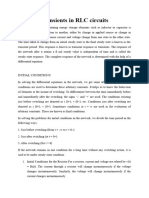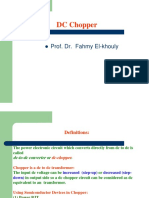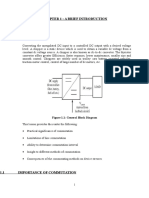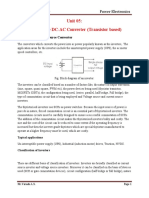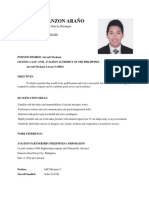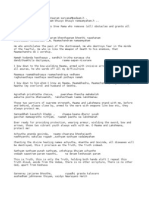1 Phase Controlled Rectifier
1 Phase Controlled Rectifier
Uploaded by
Afiq BobbyCopyright:
Available Formats
1 Phase Controlled Rectifier
1 Phase Controlled Rectifier
Uploaded by
Afiq BobbyCopyright
Available Formats
Share this document
Did you find this document useful?
Is this content inappropriate?
Copyright:
Available Formats
1 Phase Controlled Rectifier
1 Phase Controlled Rectifier
Uploaded by
Afiq BobbyCopyright:
Available Formats
Single-Phase Controlled
Rectifiers
JM610
Electrical Engineering Department
Kota Bharu Polytechnic
Mohd Azlan bin Ashari
1
SINGLE PHASE
CONTROLLED RECTIFIER
1. HALFWAVE CONTROLLED
RECTIFIER
2. FULLWAVE HALFCONTROLLED
RECTIFIER
3. FULLWAVE FULLY CONTROLLED
RECTIFIER
2
Normal rectifiers are considered as uncontrolled
rectifiers.
Once the source and load parameters are
established, the dc level of the output and power
transferred to the load are fixed quantities.
A way to control the output is to use SCR instead of
diode. Two condition must be met before SCR can
conduct:
The SCR must be forward biased (V
SCR
>0)
Current must be applied to the gate of SCR
The Half-wave Controlled Rectifier
3
The simplest controlled rectifier uses a single device, such as a
thyristor, to produce variable voltage d.c. from fixed voltage a.c.
mains. The circuit arrangement is shown below
4
The thyristor is turned on in the positive
half-cycle, some time after supply voltage
zero, by the application of a gate pulse
with delay angle o. In the negative half-
cycle, the thyristor is reverse biased and
cannot switch on. The larger the delay
angle, the smaller is the average load
voltage.
5
Voltage waveforms
for two delay angles are shown below
6
Controlled, Half-wave R load
] cos 1 [
2
) sin(
2
1
, " "
o
t
e e
t
t
o
+ =
= = =
}
s
m DC ave o
V
t d t V V V V
voltage output DC Average
t
o
t
o
e e
t
t
2
) 2 sin(
1
2
) ( )] sin( [
2
1
,
resistor, by absorbed power Average
0
2
,
2
2
+ =
=
= =
}
m
m
rms
o
rms
V
t d t V V where
R
V
R I P
rms
A gate signal is
applied at et = o,
where o is the
delay/firing angle.
R
V
R
V
I
s rms
o
rms
o
2
,
,
= =
m
7
Example
Design a circuit to produce an average voltage
of 40V across 100O load resistor from a 120V
rms
60 Hz ac source. Determine the power absorbed
by the resistor and the power factor.
Briefly describe what happen if the circuit is
replaced by diode to produce the same average
output.
8
Example (Cont)
Solution
rad
V
V
o
s
o
07 . 1 2 . 61
] cos 1 [
2
2 120
40
] cos 1 [
2
= =
+ =
+ =
o
o
t
o
t
In such that to achieved 40V
average voltage, the delay angle
must be
If an uncontrolled diode is used,
the average voltage would be
That means, some reducing
average resistor to the design must
be made. A series resistor or
inductor could be added to an
uncontrolled rectifier, while
controlled rectifier has advantage
of not altering the load or
introducing the losses
| |
V
V
V
m
rms
o
6 . 75
2
) 07 . 1 ( 2 sin 07 . 1
1
2
2 120
2
) 2 sin(
1
2
,
=
+ =
+ =
t t
t
o
t
o
W
R
V
P
rms
1 . 57
100
6 . 75
2 2
= = =
63 . 0
100
6 . 75
) 120 (
1 . 57
=
|
.
|
\
|
= pf
V
V
V
s
o
54
) 120 ( 2
= = =
t t
m
m
9
Half - Wave Controlled
Rectifier Circuit with an RL
Load
10
Figure 1 : Half-wave controlled
Rectifier with RL Load
11
Let vs(t) be Vm sin (et). At et =
0, the current through the
circuit is zero. As et becomes >
0, vs becomes positive. If a
diode instead of an SCR has
been used, the diode would
start conduction at et = 0. With
an SCR, the conduction does
not start till the SCR is
triggered. Let the SCR be
triggered when et = o. Then o
is called the firing angle and
the SCR continues to conduct.
When et = t, the source
becomes zero, but at this instant,
the current through the circuit is
not zero and there is some
energy stored in the inductor.
When vs becomes negative, the
current through the circuit would
not become zero suddenly
because of the inductor. The
inductor acts as a source and
keeps the SCR forward-biased till
the energy stored in the inductor
becomes zero. Let the current
through the circuit become zero
at et = | and the value of | > t.
For | < et < 2t, the current
through the circuit is zero
12
With an I nductive (RL) Load
13
13
14
15
With I nductive Load and
Freewheeling Diode
15
FULL-WAVE HALF-CONTROLLED BRIDGE
RECTIFIER WITH RESISTIVE LOAD
The half-controlled is the easiest to implement since the two thyristors
can be arranged to have a common cathode.
The firing circuit can have a common train of pulses and only the
forward-biased device will switch on at the arrival of a pulse on the two
gates.
Figure 1 : Circuit Diagram
16
In the positive half-cycle, T1 is turned on at delay angle
o, and current flows to the load through the path T1, load
and D1. The supply voltage then passes through zero
and reverses; since the load is resistive, T1 and D1
would turn-off.
Figure 2 : The flow of load current during +ve half cycle
17
At delay angle t + o, T2 is fired, and load current flows
through T2, load and D2. Once again, the supply voltage
passes through zero, and T2 and D2 would turn-off
Figure 3 : The flowing of load current during ve half cycle
18
Figure 4 : The input and output waveforms
19
Average load voltage (V av)
The average load voltage is found by calculating the area under the
voltage curve and then dividing by the length of the base. For any delay
angle o, the average load voltage is given by
20
In the circuit in Fig. 1, the load is replaced by a large inductance.
The assumption is that the load inductance is high enough to cause
continuous steady load current.
.
HALF-CONTROLLED BRIDGE WITH
HIGHLY INDUCTIVE LOAD
Inductive
load
Figure 5 : Half-controlled bridge rectifier with inductive load
21
Operation:
In the positive half-cycle, T1 is turned on at delay angle o, and
current flows to the load through the path T1, load and D1. The
supply voltage passes through zero and reverses; if this was a
resistive load T1 would turn-off. However, due to the inductive
stored energy, the load voltage reverses in order to keep the load
current flowing, D2 is forward-biased and conducts, and clamps the
bottom of the load to virtually zero voltage. Energy stored in the load
inductance keeps load current flowing through the path of D2, T1
and the load until T2 is fired at et = ( o + t )
The flow of load current
during ( o < et < t )
The flow of load current
during ( t < et < t+o )
22
At delay angle t + a, T2 is fired, T1 is reverse-biased and turns off,
and load current flows through T2, load and D2. Once again, the
supply voltage passes through zero, and load inductive energy
forward biases D1 to keep load current flowing. T1 is then fired, T2
turns off and the cycle is repeated.
.
The flow of load current during ( t + o) < et < 2t
The flow of load current during 2t < et < ( 2t + o)
23
Input supply
Load voltage
Load current
Input current
Current flow due
to inductive load
Figure 6 : Waveforms
24
Average load voltage
A full-wave half-controlled bridge has a supply voltage of 220V at 50Hz. The
firing angle delay o = 90
o
. Determine the values of average and rms
currents load power and power factor for a resistive load of R = 100O,
Example :
25
HALF-CONTROLLED BRIDGE WITH FLYWHEEL
DIODE AND INDUCTIVE LOAD
Although the half-controlled bridge has a fly-wheel diode action built in, it
uses one of the thyristors in the fly-wheeling path. If a third diode is
used, connected directly across the inductive load, then when the load
voltage attempts to reverse, this diode is forward-biased and the
inductive stored energy circulates the load current in the closed path of
the load and third diode
Figure 7 : circuit diagram
26
The advantage of this method is that at mains voltage zero the conducting
thyristor turns off instead of hanging on for fly-wheel diode action, and this
reduces the thyristor duty cycle.
The circuit arrangement shown in figure 7 and resulting waveforms are shown
in Figure 7b. It is clear from observation of the waveforms that values of
average and rms voltage and current are unaffected by the addition of the third
diode.
27
Input supply
Load voltage
Load current
Input current
Current flow due
to inductive load
Figure 7b : Waveforms
28
FULL-WAVE FULLY CONTROLLED BRIDGE
WITH RESISTIVE LOAD
During the positive half-cycle, T1 and T3 are turned on simultaneously at the delay
angle of o, and current flows to the load through the path T1, load and T3. The
supply voltage then passes through zero and reverses; since the load is resistive,
T1 and T3 would turn-off.
At delay angle of (t + a), T2 and T4 are fired simultaneously, and load current
flows through T2, load and T4. Once again, the supply voltage passes through
zero, T2 and T3 would turn off.
The waveforms are shown in figure 8. 29
Figure 8
Average load voltage
30
FULL-WAVE FULLY CONTROLLED BRIDGE
WITH INDUCTIVE LOAD
In the positive half-cycle, T1 and T3 are turned on at delay angle o, and current
flows to the load through the path T1, load and T3. When the supply voltage
passes through zero and reverses. the stored energy in the load is regenerating
back to the supply; T1 and T3 are maintained in conduction state. Energy stored
in the load inductance keeps load current flowing through the path of T1, load
and T3 until (T2 and T4) are fired at delay angle of (t + o).
.
The flow of load current
31
When T2 and T4 are fired at delay angle of (t + o), current flows to the load
through the path T2, load and T4 until T1 and T3 are fired at the next cycle.
The flow of load current
32
supply voltage
Output voltage
Output current
supply current
33
Average Load Voltage :
34
You might also like
- Sensor de Nivel de Refrigerante Sky Tower 50.40-m1Document34 pagesSensor de Nivel de Refrigerante Sky Tower 50.40-m1Albert Roman CamposNo ratings yet
- ZTE DC Power SystemDocument48 pagesZTE DC Power SystemAndi Fitrah NugrahaNo ratings yet
- AC-DC Converter - DDocument39 pagesAC-DC Converter - DBishnu100% (1)
- Answers of Power Electronics NewDocument9 pagesAnswers of Power Electronics NewSyed ZabiullahNo ratings yet
- Chapter 3Document18 pagesChapter 3ppat2006No ratings yet
- Module 2Document22 pagesModule 2canusha820No ratings yet
- EE 435 SCR Notes3Document32 pagesEE 435 SCR Notes3Dado GaudiNo ratings yet
- 2095784617.power Electronics Unit IiDocument59 pages2095784617.power Electronics Unit IiSaranya. M SNSNo ratings yet
- Ac Voltage Controller of Last Years PaperDocument15 pagesAc Voltage Controller of Last Years PaperIgombe IsaacNo ratings yet
- Dire Dawa University: Institute of TechnologyDocument49 pagesDire Dawa University: Institute of TechnologyAsed ZakirNo ratings yet
- PEC Lecture Slide Inverter TurkceDocument43 pagesPEC Lecture Slide Inverter Turkcemdur67No ratings yet
- DC Chopper PDFDocument37 pagesDC Chopper PDFmadhubalagangapureNo ratings yet
- DC ChopperDocument37 pagesDC ChopperAnuroopNo ratings yet
- Single Phase RectifiersDocument11 pagesSingle Phase RectifiersMiguel MartinezNo ratings yet
- Module3 1645622530Document87 pagesModule3 1645622530kanuemmanueliscoNo ratings yet
- Unit-IV (24-25)Document99 pagesUnit-IV (24-25)prasatya0706No ratings yet
- Current Commutated Chopper Through SimulinkDocument54 pagesCurrent Commutated Chopper Through SimulinkAbhijeetSinha100% (1)
- Units - 3&4Document65 pagesUnits - 3&4Vasu SureshNo ratings yet
- UNIT-V ANSWERSDocument17 pagesUNIT-V ANSWERSpandurangachariNo ratings yet
- Exp-9 11Document4 pagesExp-9 11Dave Pooja DilipkumarNo ratings yet
- My ProjectDocument5 pagesMy ProjectSashank KumarNo ratings yet
- Effect of Source InductanceDocument10 pagesEffect of Source Inductancemeeravali_snNo ratings yet
- Unit - V InvertersDocument11 pagesUnit - V InvertersSukhpal SinghNo ratings yet
- ASSIGNMENT 3 - HemakeshDocument13 pagesASSIGNMENT 3 - HemakeshHemkeshNo ratings yet
- Phase-Controlled Converters: Unit IiDocument29 pagesPhase-Controlled Converters: Unit IiChinnaGurappaNo ratings yet
- Power ElectronicsDocument15 pagesPower ElectronicsSatya Sudhakar RasamsettiNo ratings yet
- EE536 ManualDocument67 pagesEE536 Manualciraj123456No ratings yet
- Final Draft Current Commutated ChopperDocument45 pagesFinal Draft Current Commutated ChopperAbhijeetSinhaNo ratings yet
- Lecture 21Document7 pagesLecture 21adnanNo ratings yet
- Series InverterDocument5 pagesSeries Inverterinspirationnation098No ratings yet
- AC-AC ControllerDocument16 pagesAC-AC ControllerLokesh KumarNo ratings yet
- Unit 05: Single Phase DC-AC Converter (Transistor Based)Document20 pagesUnit 05: Single Phase DC-AC Converter (Transistor Based)vaibhav bodkheNo ratings yet
- Unit Iv InvertersDocument32 pagesUnit Iv Invertersswathi arshakotaNo ratings yet
- Single Phase Series InverterDocument9 pagesSingle Phase Series InverterDhivya NNo ratings yet
- Half Wave Rectifier Circuits Part (1-A) : Experiment: DiodeDocument13 pagesHalf Wave Rectifier Circuits Part (1-A) : Experiment: DiodeCatalina ZelayaNo ratings yet
- PSIM MANUAL For StudentsDocument23 pagesPSIM MANUAL For StudentsSomnath Khamaru75% (4)
- Controlled Rectifier Single Phase Full WaveDocument7 pagesControlled Rectifier Single Phase Full WaveJesus BecerraNo ratings yet
- Buck ConvertersDocument4 pagesBuck ConvertersAbenav SankarNo ratings yet
- Phase Controlled RectifiersDocument59 pagesPhase Controlled RectifiersAravindh EnggNo ratings yet
- Tan Kien Hau (01Dem16F1004) ONG KANG WEI (01DEM16F1006) Lee Zhi Shern (01Dem16F1038) Zulhilmi (01Dem16F1007)Document18 pagesTan Kien Hau (01Dem16F1004) ONG KANG WEI (01DEM16F1006) Lee Zhi Shern (01Dem16F1038) Zulhilmi (01Dem16F1007)Eden HazardNo ratings yet
- Single-Phase Inverters: Seminar by Supervised byDocument45 pagesSingle-Phase Inverters: Seminar by Supervised bynoor deenNo ratings yet
- Experiment 5 Aim TheoryDocument6 pagesExperiment 5 Aim TheoryHarsh GuptaNo ratings yet
- Report Converter 3Document7 pagesReport Converter 3عمار الشهاريNo ratings yet
- Circuitos Pulsadores Con Tiristores Pulsadores Conmutados Por ImpulsoDocument4 pagesCircuitos Pulsadores Con Tiristores Pulsadores Conmutados Por ImpulsoALEX_125No ratings yet
- 10ec73 Unit4Document32 pages10ec73 Unit4accfrosaNo ratings yet
- Second Order Circuits - Intro - 290923Document4 pagesSecond Order Circuits - Intro - 290923Adan BagajaNo ratings yet
- Lab 1 DJM 40103 Psim 2Document23 pagesLab 1 DJM 40103 Psim 2aiman.haziq2913No ratings yet
- Basics of Buck Boost BasicsDocument11 pagesBasics of Buck Boost BasicsAnil KoulNo ratings yet
- Thevenin Norton's Theorem (Copy)Document19 pagesThevenin Norton's Theorem (Copy)M Syafiq SamadNo ratings yet
- Electrical-Engineering Engineering Power-Electronics Inverters NotesDocument22 pagesElectrical-Engineering Engineering Power-Electronics Inverters NotesAbdelrahman Magdy EbrahimNo ratings yet
- E1 - Controlled Rectifiers PDF NotesDocument84 pagesE1 - Controlled Rectifiers PDF NotesSatyanarayana Gurram100% (1)
- High Voltage DC Transmission 2: Inverters. The Term Converter Is Used To GenericallyDocument25 pagesHigh Voltage DC Transmission 2: Inverters. The Term Converter Is Used To GenericallyadnanNo ratings yet
- S6 PE Lab Manual 2018 MATLAB PDFDocument27 pagesS6 PE Lab Manual 2018 MATLAB PDFhariNo ratings yet
- 6 Solid State Motor Control Induction Motor Speed Control PDFDocument22 pages6 Solid State Motor Control Induction Motor Speed Control PDFdimitaringNo ratings yet
- RHPZ, A Two Way Control PathDocument11 pagesRHPZ, A Two Way Control PathkurabyqldNo ratings yet
- Laboratory NR 6Document5 pagesLaboratory NR 6IonutNo ratings yet
- Ee 328 Lecture 11Document55 pagesEe 328 Lecture 11somethingfornowNo ratings yet
- Power Electronics L2 ConvertersDocument6 pagesPower Electronics L2 ConvertersBakri BugaNo ratings yet
- Design of Electrical Circuits using Engineering Software ToolsFrom EverandDesign of Electrical Circuits using Engineering Software ToolsNo ratings yet
- Recipient Eligibility Determination Audit (REDA) Round 2Document2 pagesRecipient Eligibility Determination Audit (REDA) Round 2Lydia CowartNo ratings yet
- HR TechnologyDocument6 pagesHR Technologyabmbitha100% (1)
- M1Document3 pagesM1Curt Aludos BangloyNo ratings yet
- STA642 Assignmetn Solution Abdul Hadi e ServicesDocument2 pagesSTA642 Assignmetn Solution Abdul Hadi e ServicesAhmeddedNo ratings yet
- BUS 1101 Principles of Business Management - Term 2, 2018-2019Document11 pagesBUS 1101 Principles of Business Management - Term 2, 2018-2019Lynn M. BarakatNo ratings yet
- A320-X Flight Checklist PDFDocument2 pagesA320-X Flight Checklist PDFcarlosjricoNo ratings yet
- Standard For Essential Composition of VCO PDFDocument11 pagesStandard For Essential Composition of VCO PDFUbais AliNo ratings yet
- D&D Items and CostsDocument23 pagesD&D Items and CostsJohn ChiltonNo ratings yet
- Chapter 1 and 2Document20 pagesChapter 1 and 2Neljane LaurenteNo ratings yet
- Boats and Streams - Aptitude Test Tricks, Formulas & ShortcutsDocument5 pagesBoats and Streams - Aptitude Test Tricks, Formulas & Shortcutshoney1002No ratings yet
- Green - S - Theorem IntuitionDocument7 pagesGreen - S - Theorem IntuitionLi DuNo ratings yet
- Maclura Pomifera (RafDocument10 pagesMaclura Pomifera (RafdeatristeNo ratings yet
- ARG Vol 87 No 3 May-Jun 2023Document193 pagesARG Vol 87 No 3 May-Jun 2023Adam AnoNo ratings yet
- ResumeDocument4 pagesResumeroyarvin0% (1)
- Fundamentals of Well Stimulation TechniqueDocument58 pagesFundamentals of Well Stimulation Techniquechemical todiNo ratings yet
- Blockchain MergedDocument71 pagesBlockchain Mergedcvam04No ratings yet
- Assignment 1 FWTDocument7 pagesAssignment 1 FWTeyraNo ratings yet
- Multiple Choice Test ConstructionDocument16 pagesMultiple Choice Test ConstructionJoanne Ico MagnayeNo ratings yet
- Vibration Analysis of Beam Subjected To Moving Loads Using Finite Element MethodDocument11 pagesVibration Analysis of Beam Subjected To Moving Loads Using Finite Element MethodIOSRJEN : hard copy, certificates, Call for Papers 2013, publishing of journalNo ratings yet
- A Review of Implementing ADC in RFID SensorDocument15 pagesA Review of Implementing ADC in RFID SensorpradozuritaNo ratings yet
- Presentation 1Document18 pagesPresentation 1amanda.melton1No ratings yet
- Ideation TheoryDocument8 pagesIdeation TheoryHafiz Umair ArshadNo ratings yet
- Daily Lesson Log For Catch Up FridayDocument5 pagesDaily Lesson Log For Catch Up FridayFreana Rose Ison Buenviaje IINo ratings yet
- Attachments Brochure FinalDocument16 pagesAttachments Brochure Finalkomatsu2562No ratings yet
- Consent Form APAAR Modified ApprovedDocument1 pageConsent Form APAAR Modified Approvedneerasingh30872100% (2)
- Sri Rama Dhyana StotramDocument2 pagesSri Rama Dhyana Stotramraj100% (1)
- Emelect 1 (Midterm)Document18 pagesEmelect 1 (Midterm)lozanojurryNo ratings yet
- Script For Head To NeckDocument7 pagesScript For Head To NeckRhelina MinNo ratings yet




